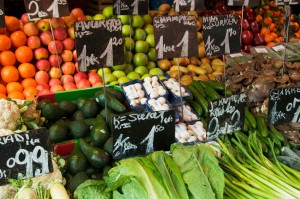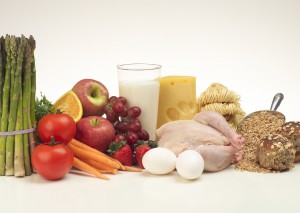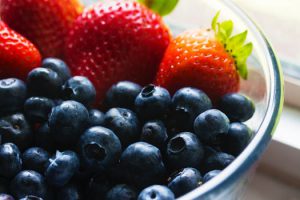FEATURED ARTICLES
- Details
- Written by Lisa Jillanza
Before hitting the grocery store or produce stands this season, check out what fruits and veggies you should be getting:

- Apricots : slightly soft, not bruised
- Artichoke : compact head, bright green color
- Asparagus : closed and compact tips, bright green stalks
- Avocado : should be a little “give” when squeezed
- Carrots : crisp, healthy tops
- Collard Greens : dark green, vibrant color
- Mango : more orange/red than green
- New Potatoes : last only a few days
- Pineapple : sniff the bottom for sweet aroma, check for firmness
- Rhubarb : check for bright, crisp stalks
- Spinach : avoid dried out or yellow stems
- Strawberries : pick fragrant, slightly soft ones
- Sugar Snap/Snow Peas : bright green, should feel like they have a snap (not limp)
- Details
- Written by Lisa Jillanza
Every year, more than 9 million people come down with a food borne illness and according to the Centers for Disease Control (CDC) it is more than likely the foods that you are eating every day that are making you sick and not something out of the ordinary.

While the Food and Drug Administration (FDA) is working hard to enforce higher safety standards on farms, they have linked many of these illnesses to three major areas.
Here are some examples of foods that may in fact be making you sick.
Green leafy vegetables : various strains of E.Coli have been found on green leafy vegetables and according to the CDC study resulted in the highest percentage of illness.
Poultry : diseases in poultry killed the highest number of people in the CDC study, with listeria being the cause.
Dairy : 14 percent of all food borne illnesses were the result of contaminated dairy products, including ice cream and cheese.
- Details
- Written by Lisa Jillanza
Whether you heard it from your great aunt Millie or from your grandma's neighbor, at some point in your life you have been told a home remedy or two that simply did not make any sense. While there are plenty of home remedies that are more folk lore than fact, there are others that do indeed work. Here are some home remedies that were put to the test to determine : fact or fiction?

Honey helps heal wounds, FACT.
Because of its antibacterial properties, honey is most effective as a wound healing agent. According to studies, honey has an inhibitory effect to more than 60 different species of bacteria. To heal a wound with honey, apply liberally and cover with a nonadherent dressing; change dressing once or twice a day.
A penny over a bee sting relieves pain and swelling, FICTION.
Unfortunately there is no medical evidence to show that putting a penny over your bee sting will relieve the pain and swelling. Instead you should use aloe vera gel and apply it liberally or until it is absorbed, about 4 times a day.
Licorice helps heal sore throats, FACT.
Don't run out and get a bag of candy though when you have your next sore throat because even though licorice helps heal sore throats, it is the active ingredient in the licorice root that actually has the healing power. You can find licorice tea bags in most drug stores that will help to heal sore throats if you drink them twice a day upon feeling your first symptoms. Two notes though, don't drink your tea after 6 p.m. as it may cause sleeplessness and do not take it if you have high blood pressure.
White flour on a small burn helps it to heal, FICTION.
White flour may not help a small burn to heal, but luckily the small burn category has a number of home remedies that do in fact work. One suggestion is to use diluted apple cider vinegar (diluted with equal parts water) to apply to the burn. You can also try honey, tea bags, oatmeal or milk. If you go the tea bag route, apply wet, cool tea bags to the burn or you can soak a cloth in milk and apply it to your burn for 15 minutes, repeating every few hours for pain relief.
- Details
- Written by Lisa Jillanza
The acai berry represents a new trend in weight loss efforts, but its pound-dropping effectiveness may be questionable.

Although some claim that drinking the berry juice can stimulate weight loss, few studies can actually justify this theory according to www.webmd.com.
Although the acai berry may not actually help you lose weight, it is beneficial to you. Like other berries in the same family, the acai berry has many antioxidants and is a good part of any diet.
Any fruit with high antioxidant content can help prevent heart disease and cancer.
Those with allergies to pollen, however, should be cautious. Some allergy sufferers have been sensitive to this berry and should avoid it.
In conclusion, should you incorporate the acai berry into your diet? Of course! It has a place there, just like all fruits.
Should you base your weight loss regimen solely on this fruit? Probably not.
- Details
- Written by Lisa Jillanza
Sure, you would be hard-pressed to find a woman or a man who says that they actually enjoy the thoughts of spring cleaning,
But, if you just take into consideration how many calories are burned while you are doing your spring cleaning, then you may be a little more excited when spring rolls around this year.
The actual amount of calories burned will depend on your weight, gender and age, but there calculators that you can find online (FitDay or NutriStrategy) that will help you to calculate your actual calories burned.

So dust off your mops, break out the cleaner and begin to sweat off the weight!
Gardening: 226 calories
Window washing: 226 calories
Scrubbing floors (on hands and knees): 291 calories
Laundry, ironing: 84 calories
Sewing repairs: 36 calories
Dusting: 97 calories
Scrubbing toilets, tub: 246 calories
Vacuuming: 317 calories
Cleaning gutters: 258 calories
Moving furniture, household items: 387 calories
Painting, papering, plastering: 317 calories
Sweeping: 194 calories
Mopping: 153 calories
Mowing the lawn: 148 calories
Washing dishes: 77 calories

